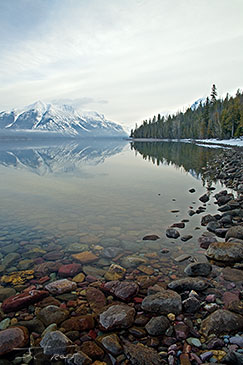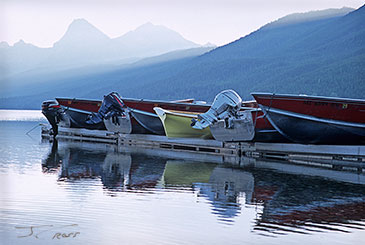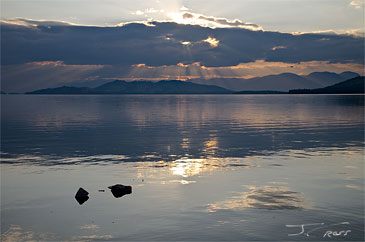www.lumen-perfectus.com
The Portfolio
portfolio |pôrt' fōlē ō|
noun ( pl. -os)
– a large, thin, flat case for loose sheets of paper such as drawings or maps.
– a set of pieces of creative work collected by someone to display their skills, esp. to a potential employer.
– a varied set of photographs of a model or actor intended to be shown to a potential employer.
A couple of years ago I was asked to submit a selection of work to a regional hospital for a large new addition they were about to open. They were looking for work from local artists, in all media, to be displayed in waiting rooms, common areas, and patient rooms. The only criterion was that the work have some local connection — area landscapes, regional wildlife, local materials, etc.
I had a meeting with the hospital's CEO. He gave me a tour of the nearly-ready facility, so I had a good idea of the sort of imagery they wanted, the sizes needed, and the areas in which the work would be displayed. My next task was to create a portfolio of pictures to submit to their selection committee. This is where things got interesting.
Are We Having Fun Yet?

I'd never created a portfolio; it sounded like a fun thing to do. It would be a simple matter to select a reasonable number of pictures I felt would best suit the (potential) client's needs. We'd previously agreed the submission would be via e-mail, so it would not be necessary to produce prints for the portfolio. I'll touch on the pros and cons of this a bit later.
Did I say this would be fun? You'd think it would be. Looking through dozens of images, sorting and selecting, putting together a list of the very best within the appropriate categories. I wanted this commission, so I was determined to maximize my only shot at making a good impression. It didn't take long to reduce the number of candidate photos to around 50. But 50 was three times the number requested, so further culling would be required. I looked through those 50 pictures for hours, spread over several days. I liked them all, and they all seemed appropriate, meeting the stated requirements. It was time to get brutal.
If you've created portfolios of your work, you know what a challenge it can be, especially the first couple of times you do it. I can't tell you how to select photos for your own portfolios, but I can describe my experience creating an 18-picture portfolio designed to meet specific requirements. Several photographer friends have related similar stories; clearly mine is not unique. Bottom line: this is hard! But I can assure you it gets easier as you produce more portfolios of your work, whether these are sets of prints, Web collections, slide presentations, or other groupings.
I had no choice but to remove from contention a number of pictures I really liked, and which I felt sure the selection committee would like. I had to take more than 30 images out of the running, but in doing so I had to be sure I was left with those most likely to impress the committee and win me the job. I really struggled with this. I was nearing the deadline and making no progress. I asked my wife to review the 50, but being the smart person she is, she wanted no part of it. She could see it was making me crazy and didn't want to join in the madness. Her only advice sounded like something from a Nike® ad.
But in the end, "Just Do It"™ is exactly what I did. With the selections made, I put together a Web site to display them, emailed the URL to the selection committee, did some follow-up, and waited. I got the job, and the committee also chose three photos from my public site. Perhaps the selections I made for the private portfolio site led the committee to have a look at more of my work. The photos on this page, including the panorama at the top, are among those selected.
Web vs. Print Portfolios

The Web is a great medium for viewing photographs. Thanks to cell phones, high-end professional gear, and everything in between (or beyond), everyone's a photographer. For better or for worse, their photos are "shared" by the millions on social networking sites. Photos can be prepared specifically for display on the Web; with a bit of effort the results can be outstanding, but the results can be at least OK with almost no effort at all. This is an inexpensive means of getting your photos in front of a lot of people. Not including camera and computer (and time, of course), the cost can be minimal. Generally speaking the "freebie" sites often aren't adequate for professionals, whose sites need to be commercial vehicles for selling their work. Even sites produced at a cost by Web developers are inexpensive to maintain once they're established and debugged, making them a cost-effective means of displaying quality work.
But there are down-sides to the "virtual" gallery. Color matching is an issue. While most professional photographers work in color-managed environments, that is, with monitors (at least) calibrated to display accurate color, brightness, and contrast in their viewing environment, calibrated monitors are not common among the general browsing public. When a new computer, whether a desktop with a separate monitor or a laptop with an attached screen, is set up, the monitor as it comes from the box is always set extremely bright and contrasty. This may be OK for business graphics, but it's terrible for viewing photos. People don't realize this and rarely make any adjustments to their monitors during the life of the system. What I see on my calibrated monitors when I prepare a photo for display on the Web is not what a typical viewer would see. Tone, saturation, shadow and highlight detail, and overall color will be different. The very qualities that make a winning image may be lost entirely on the typical too-bright, high-contrast monitor.
It can also be difficult to walk in to a gallery or a potential client's home or business with a virtual portfolio. They may have Web access, but unless such a viewing is prearranged, it would be awkward at best, and there'd still be the color matching problem.
A well-made print portfolio can do a lot to solve these problems. The prints would be made using a color-managed workflow, so the color and other aspects of each print would be "right", at least under a given viewing light. Whether the prints are matted or not, there's no substitute for holding a fine print in one's hands. There are many printing papers available today, and the artist can choose papers so the print appears exactly as he or she intends. A print is opaque and reflects the available light, while the image on a monitor generates light — completely opposite technologies.
The Tenset
But all this is a diversion from the real task, which is making selections from a larger body of work.
Michael Johnston wrote an interesting piece for his Online Photographer blog, which he titled The Tenset. In it he describes his annoyance with many Web sites presenting photographic work. I'd summarize his complaint as "quantity over quality" coupled with a lack of organization. He suggests we be more ruthless in our culling, at least as far as what we post is concerned. He offers suggestions for posting photographs to Web sites, and wishes photographers' sites presented no more than ten images at the outset, those being the ten best the photographer has to offer. Mr. Johnston believes if the first ten photos you see on a site don't grab you, you won't browse further no matter how many pictures are presented. If the first ten amaze and delight you, you'll browse deeper and perhaps contact the photographer. Mr. Johnston also complains that sites with many images tend to be poorly organized, often can't be searched in any reasonable way, making it impossible to find the photos one might be interested in pursuing. That problem goes away if there are only ten images. This is an intriguing idea. What if you had to select a maximum of ten photos from your catalog of thousands? And what organizational scheme could possibly help find specific types of photos when there are dozens or hundreds to browse?

I completely agree with his comments regarding site organization. My site is organized in one of the ways Mr. Johnston condemns; if I could think of a better way to set things up, I'd do it. (It is, however, searchable.) Suggestions welcome. However, I don't think the "tenset" concept would work for most photographers' Web sites. People are busy, often distracted and impatient. This probably isn't the best disposition to have when browsing art. Cranky people generally don't have a pleasant time browsing brick-and-mortar galleries or museums, either. I think people intent on buying, on filling a need (available wall space, gaps in their collections, gift purchases, or any of a thousand reasons people buy art) will take the time to browse a reasonable collection of images, especially one that's well organized and can be searched.
When it comes to creating a portfolio, however, I think Mr. Johnston's tenset is a brilliant concept. You want to present your very best work, and you want to organize those images in a way that makes sense to your audience. The tenset idea applies, whether your portfolio has ten or a dozen or twenty images.
Create Your Own Portfolio
I'm not suggesting every picture you make should be for commercial purposes, or for any specific purpose or market. I love to experiment when making photographs. Some of these are successful, some aren't. But even the successful ones may be a bit "edgy", or too abstract or otherwise not suitable for shows and the more typical client base where I live. I will not stop making such pictures; it's something I love to do, and an expanding client base beyond where I live seems to be more open to such work. In addition, I often make pictures just for me. But I'm less likely to display such work when my goal is sales in a market not comfortable with work that's a little outside the mainstream. If you are creating portfolios to help sell your work, you might find some of these suggestions helpful:
March, 2010